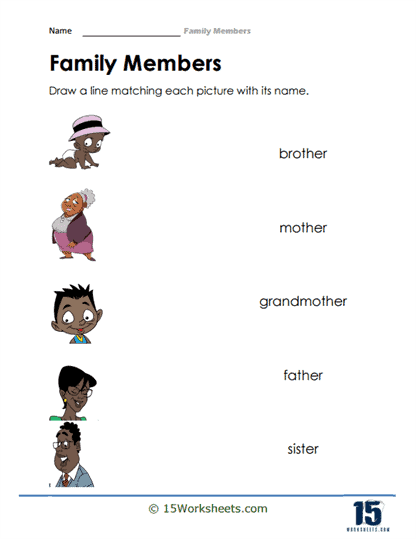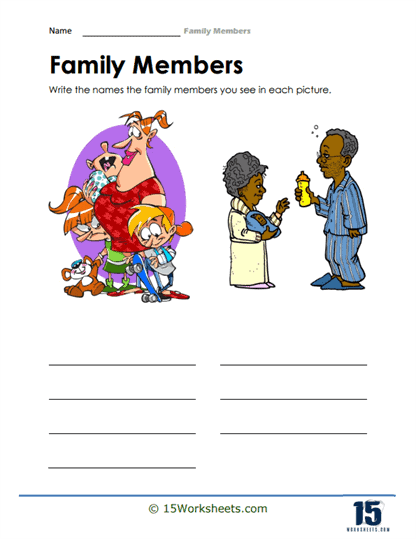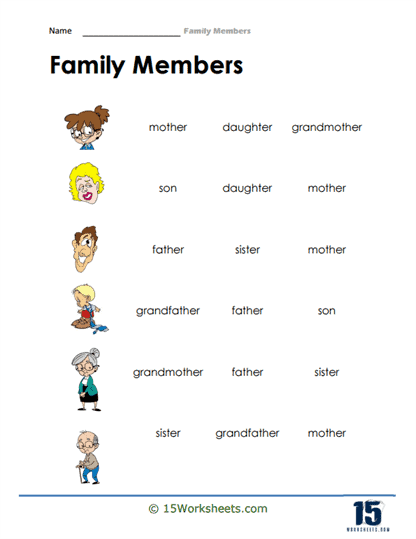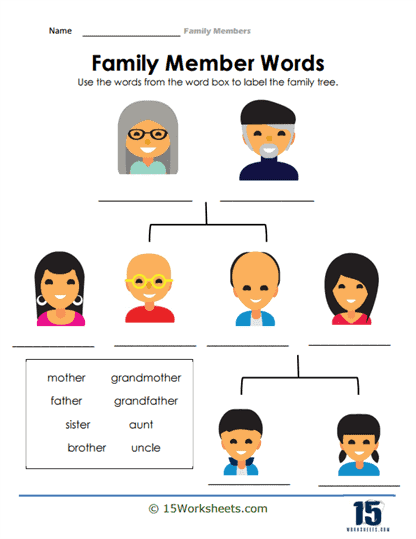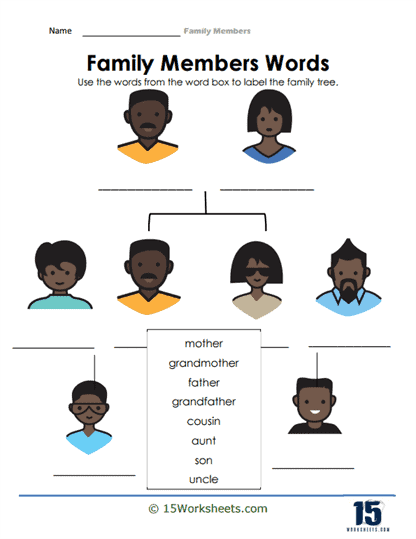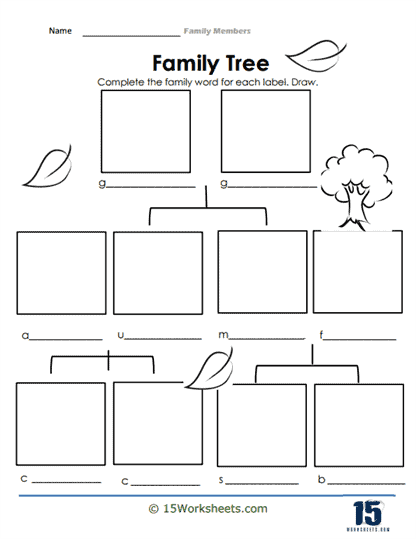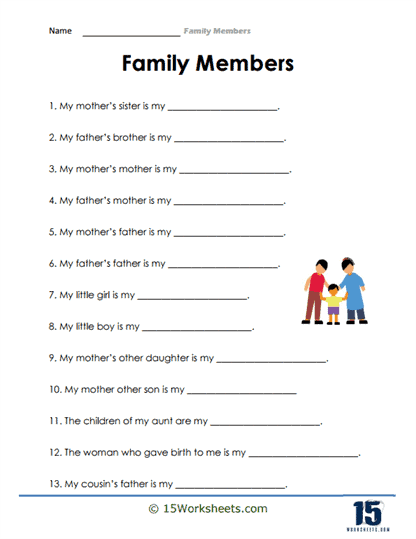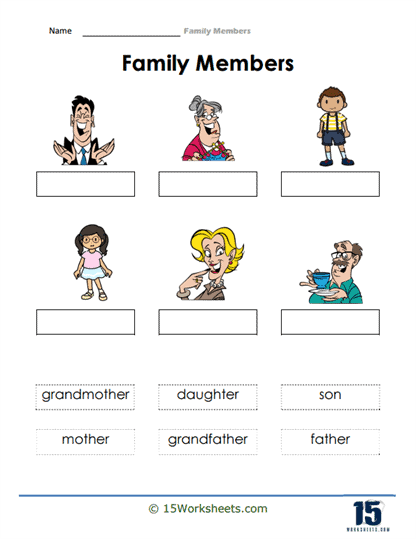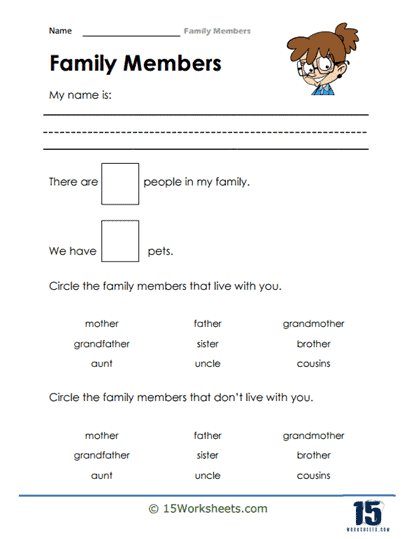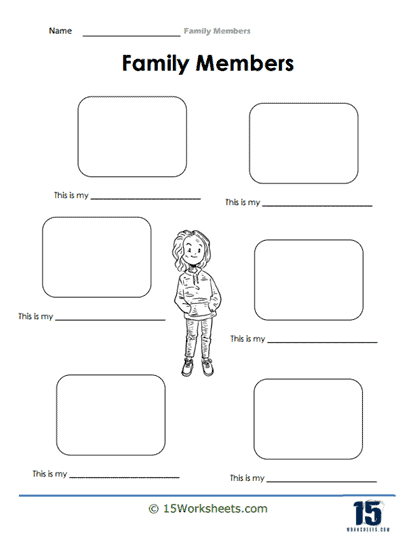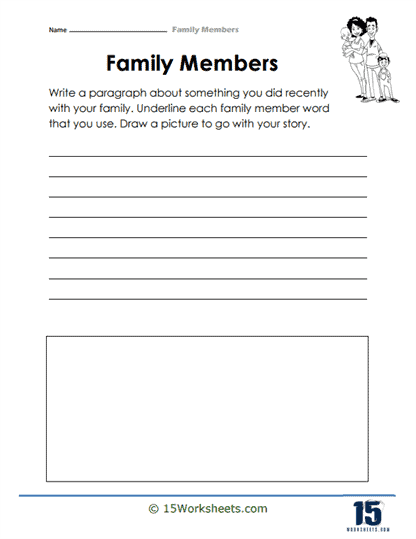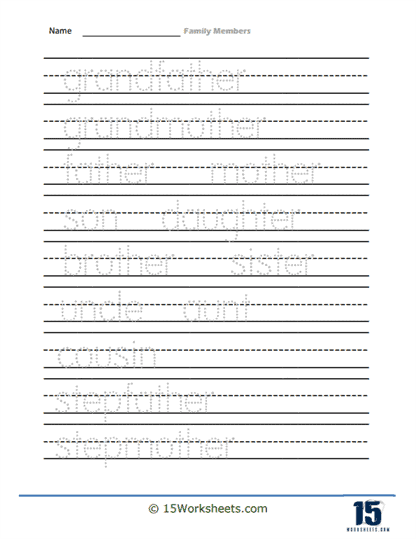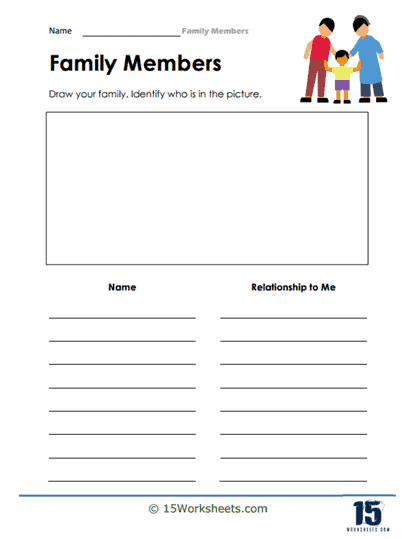Family Members Worksheets
All About These 15 Worksheets
This collection of 15 thoughtfully designed worksheets offers a comprehensive and engaging way for students to dive into the vocabulary associated with family members. Whether in a traditional classroom setting or a homeschooling environment, these worksheets aim to guide students through the process of learning the names of various family members and understanding the intricate relationships that connect them. Through a variety of exercises, students are encouraged to explore not only the language associated with family but also the cultural and social importance of these relationships.
At the heart of these worksheets is the objective to teach students the names of different family members, from immediate to extended relatives, while also helping them grasp how these individuals are connected. For example, one of the primary exercises involves the use of pictures as visual clues. Students are presented with images of family members, and through these illustrations, they are encouraged to associate the visual representation with the correct vocabulary term. This method of using imagery is particularly effective for young learners, as it taps into their natural ability to learn through observation. By linking pictures with words, students can more easily recall and use the vocabulary in real-life conversations.
If a classroom is Hogwarts, then the “Picture Word Matching” and “Tracing Words Practice” sheets are basically the Sorting Hat in crayon form. Students stare down grinning clip-art grandmas and must decide, with the solemnity of a tiny lexicographer, whether that label says grandma or the-lady-who-brings-cookies. Then they trace the letters until the words seep into muscle memory-equal parts handwriting workout and linguistic Jedi mind-trick. Beware: after a few rounds, kids may start labeling everything in the house, including the dog, the sofa, and possibly you.
Next come the sleuthing worksheets-“Which Members Do You See?,” “Who Is This?,” “Who’s In The Picture?,” and “This Is My…“-where students transform into pint-sized private eyes rummaging through cartoon family reunions. They cross-examine Uncle Bob’s mustache, triangulate baby-to-parent nose geometry, and shout “Eureka!” when they spot a sibling. These tasks sneak-teach pronouns, possessives, and polite ways to say, “No, that’s Auntie-not a random lady stealing cake.” It’s logic, language, and comedy of errors rolled into one detective drama.
Feeling confident, our mini-genealogists grab metaphorical hardhats for “Label The Tree,” “Labeling The Structure,” “Family Tree Drawing,” and “Relation To Each Other.” Here they blueprint ancestry like tiny civil engineers: siblings are horizontal beams, grandparents the load-bearing walls, and cousins-well, cousins are that annex nobody can quite explain. By mapping second cousins once removed, kids discover both kinship vocabulary and the existential truth that family is essentially a sprawling, slightly lopsided skyscraper held together by shared Wi-Fi passwords.
Of course, theory needs glitter. Enter the kinesthetic trio: “Cut And Paste,” “A Drawing Of My Family,” and “Illustrating My Family Members.” Scissors snip, glue sticks ooze, and suddenly Grandma sports dragon wings. Artistic license becomes a diplomatic mission: “Yes, Mom, I meant to give you a superhero cape.” Motor skills sharpen while imaginations go joy-riding, proving that nothing cements a vocabulary word like physically gluing your uncle’s cartoon head onto a pizza.
Finally, the worksheets dim the lights for reflective storytelling: “All About My Family” and “My Family Story.” Students compose epic sagas where the dog is the heroic sidekick, Grandpa is a time-traveling saxophonist, and every argument over the TV remote becomes myth. Beneath the giggles lurks a deeper lesson: writing about family teaches empathy, perspective-taking, and the sublime realization that even the quirkiest households are, in their own melodious disarray, perfectly human. And that, dear pedagogues, is a homework assignment worth framing on the fridge.
How to Name Family Members
In the English language, specific names are given to each family member. These names are based on the family member’s gender and relation to a specific person.
Family members, also known as relatives, are divided into immediate (or nuclear) and extended (or distance). In the following examples, family members are named based on their relation to person A.
Naming Immediate Family Members
Person A’s immediate family consists of a father (male) and mother (female), who are A’s birth parents. If either of these individuals is not A’s birth parents, they become the adopted father and adopted mother, respectively. Any other offspring that A’s parents have are A’s siblings called a brother (male) and sister (female).
Suppose A’s parents get divorced and remarry other people. In that case, these new additions are stepparents. The father’s new wife is A’s stepmother, while the mother’s new husband is A’s stepfather. Any subsequent offspring will be A’s half-sibling, specifically half-brother (male) and half-sister (sister).
A’s spouse would either be a husband (male) or wife (female), with their resulting children being sons (male) or daughters (female). Suppose A’s spouse has children from a previous relationship. These children become A’s stepchildren, named stepson (male) and stepdaughter (female).
Naming In-Laws
Suppose B is the spouse of A. Since marriage is a union bound by law, every member of B’s family is now that relative-in-law to A. Therefore, B’s father and mother are A’s father-in-law and mother-in-law. B’s siblings are A’s brother-in-law and sister-in-law. B’s grandparents are A’s grandfather-in-law and grandmother-in-law.
Naming Extended Family Members
Each of A’s parents has their own set of parents. They are A’s grandparents, known as grandfather (male) and grandmother (female). Note that there is no distinction between grandparents on the father’s or mother’s side. Person A has two sets of grandparents.
If either of A’s grandparents has siblings, they become A’s great-uncle (male) and great-aunt (female).
Each grandparent has its own set of parents. These relatives are A’s great-grandparents. They are called great-grandfathers (male) and great-grandmothers (female). Person A has four sets of great-grandparents.
If either of A’s siblings gets married, then their spouses would be either A’s brother-in-law (male) or sister-in-law (female). Any children from these marriages become A’s nephews (male) and nieces (female).
If A’s children marry, their spouse becomes A’s son-in-law (male) and daughter-in-law (female). Any children from these unions become A’s grandsons (male) and granddaughters (female). These children are also great-grandchildren to A’s grandparents. And great-great-grandchildren to A’s great-grandparents.
If either of A’s parents has siblings of their own, they become A’s uncles (male) and aunts (female). The people who marry A’s uncle or aunt have no blood relation to A and therefore are known as uncle by marriage and aunt by marriage. Any children, male or female, that A’s uncle or aunt has with their spouses are A’s first cousins.
If any of A’s cousins get married, these individuals do not have any blood relation with A and are known as the cousin’s husband (male) or wife (female). However, any children from these marriages are A’s cousins once removed.
A Note On Cousins
The degree of cousins depends on which generation of grandparents they have in common. For example, a first cousin shares a common grandparent; a second cousin will share a common great-grandparent. The third cousin shares a common great-great-grandparent, and so on.
When any degree of a cousin has a child, that child becomes the same degree once removed. For example, the child of a first cousin is the first cousin once removed, while the child of a third cousin is a third cousin once removed.

